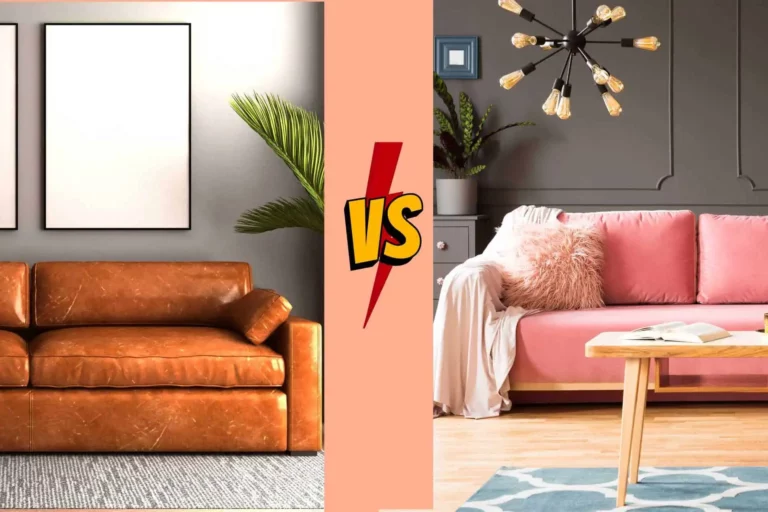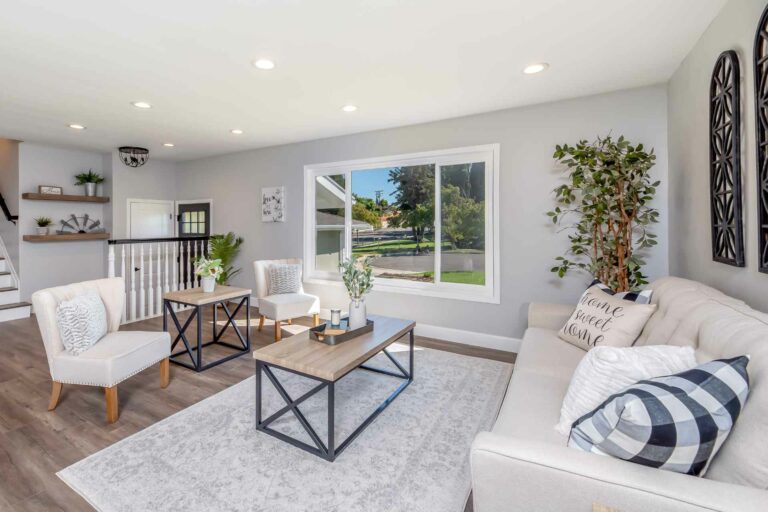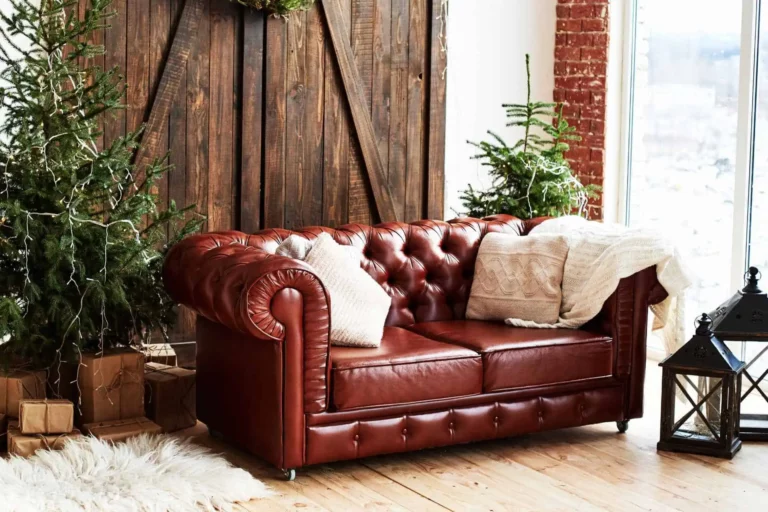Top 10 Strategies on How to Decorate a Living Room with High Ceilings
Decorating a home can be an exhilarating yet challenging endeavor, particularly when it comes to figuring out how to decorate a living room with high ceilings. High ceilings bestow a sense of grandeur and openness, turning your living space into an inviting canvas for design and creativity. However, their towering height can also present unique challenges, from creating a sense of warmth and intimacy to ensuring everything is in scale. Our guide aims to equip you with top strategies to transform your high-ceilinged living room into a space that is not only aesthetically pleasing but also comfortable and inviting. With the right approach, the sky is truly the limit when decorating such a space. Buckle in and immerse yourself in our detailed exploration of how to decorate a living room with high ceilings.
Understanding High Ceilings
The Appeal of High Ceilings
High ceilings are a desirable architectural feature in many homes, given their ability to create a sense of spaciousness and luxury. They offer an unparalleled feeling of expansiveness, often making a room appear larger and more grandiose than it actually is. They also enable better air circulation, enhancing the overall comfort and freshness of the living space. High ceilings are particularly beneficial in warmer climates, where the additional height allows the hot air to rise, keeping the lower levels of the room more comfortable. Moreover, these lofty spaces offer an excellent opportunity for creative design elements such as statement light fixtures or dramatic wall decor. Thus, the appeal of high ceilings lies in their ability to blend functionality with aesthetic appeal, making a home feel both extensive and elegant.
Challenges in Decorating High Ceilings
While high ceilings can provide a stunning aesthetic, they also present unique challenges when it comes to decorating. One issue homeowners often face is the daunting task of filling the vertical space without making it feel overwhelming or cluttered. Striking the right balance between utilizing the available height and maintaining a warm, inviting environment can be tricky. Another challenge is choosing the appropriate scale for furniture and artwork. Pieces that are too small can be dwarfed by the high ceilings, making the room feel out of proportion. On the other hand, items that are too large can dominate the room, creating an imposing and uncomfortable atmosphere. Lighting is another critical aspect that can be problematic, as conventional lighting setups might not be sufficient to adequately illuminate a high-ceiling room. The height might also pose practical difficulties when it comes to maintenance and cleaning. Navigating these challenges requires thoughtful planning and design solutions.
How to Decorate a Living Room with High Ceilings – 10 Strategies
Utilizing Vertical Space
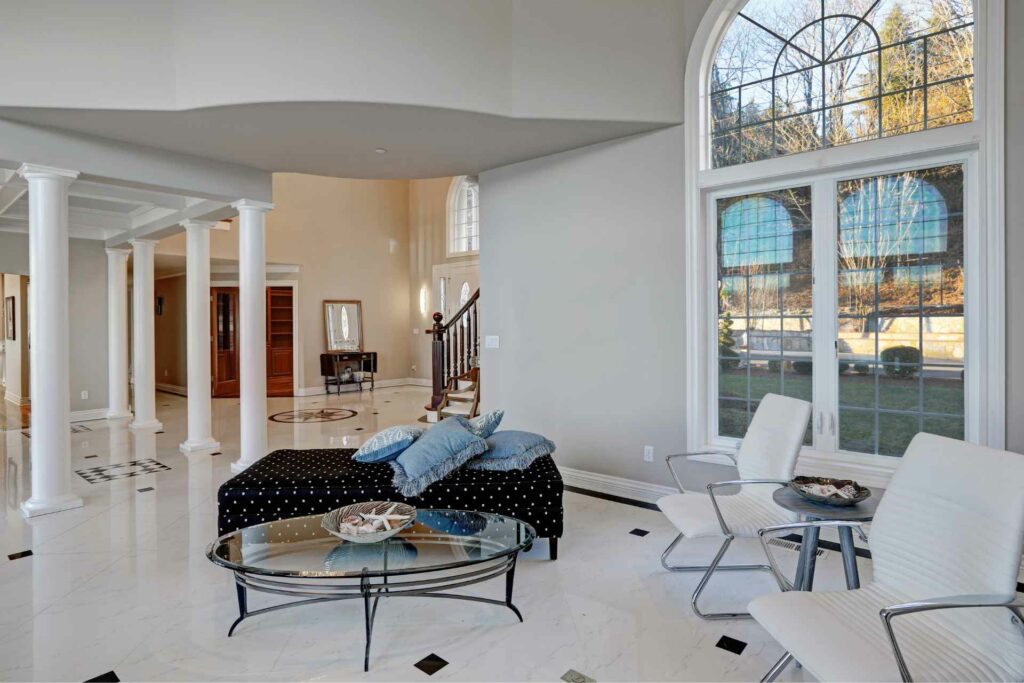
Leveraging the vertical space appropriately is paramount in decorating a room with high ceilings. One effective strategy is to hang artwork or tapestries that span the majority of the wall’s height, which can help draw the eye upwards and maintain a sense of balance in the room. Installing tall bookcases or shelves is another practical way to use the vertical space, providing ample storage while also contributing to the room’s aesthetic. Utilizing plants of varying heights can create a dynamic visual interest, especially when they are arranged in clusters or on staggered shelving. In terms of window treatments, full-length curtains from ceiling to floor can add a touch of elegance and continuity. However, care should be taken to not overfill the space, which can result in a cluttered and overwhelming appearance.
The Importance of Lighting
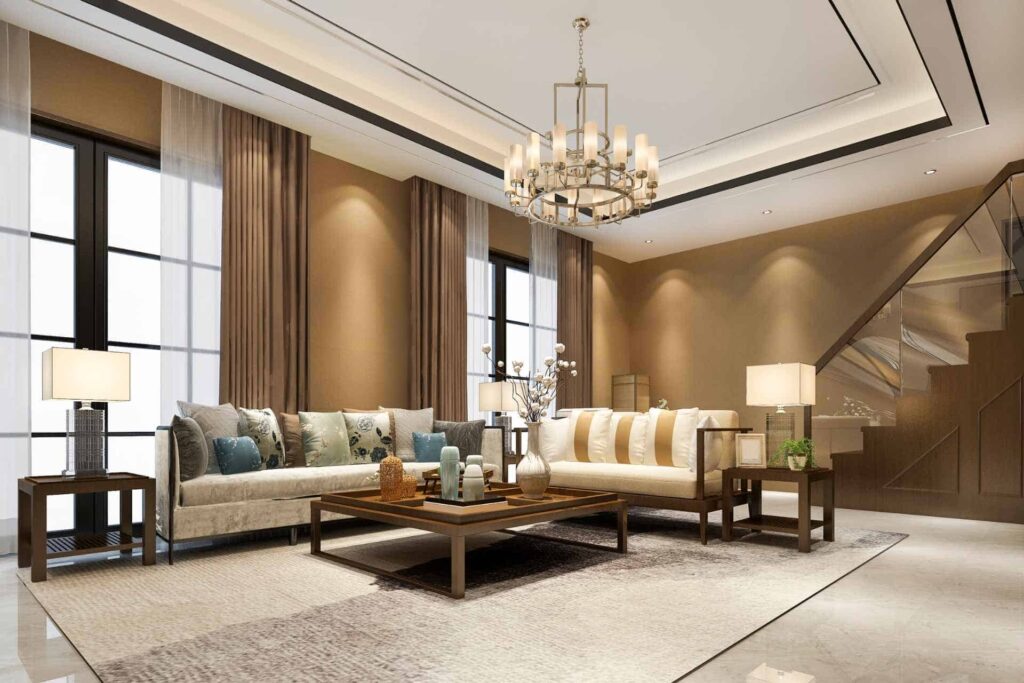
Lighting plays a pivotal role in rooms with high ceilings, not only for its functional aspect but also as a powerful design tool. The right lighting setup can accentuate the room’s architectural features, create a warm and inviting ambiance, and ensure that the space is well-lit. Pendant lights or chandeliers can be hung at varying heights to draw attention to the ceiling’s height and add a dramatic flair. Recessed lighting or track lighting, strategically placed, can highlight artwork or other design elements. Equally important is the use of natural light which, when harnessed effectively through windows or skylights, can make the room feel airy and open. Nonetheless, it’s crucial to balance the light sources to avoid overly bright or shadowy spots, ensuring a comfortable and visually pleasing environment.
Artwork and Wall Decor Considerations
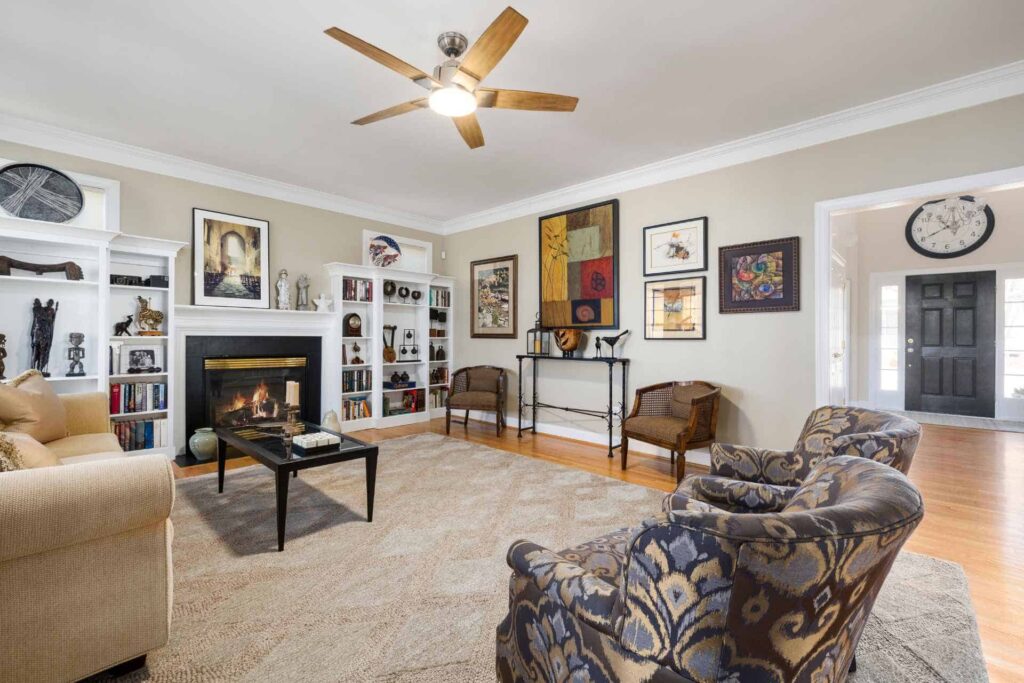
Artwork and wall decor are essential aspects when decorating rooms with high ceilings, as they can help to break up the empty space and add character. Oversized artwork or a large-scale wall mural can become a stunning focal point, effectively drawing the eye and making a bold statement. Alternatively, a gallery wall with smaller pieces arranged in a cohesive pattern can also fill the vertical space and provide an opportunity to showcase personal tastes. Mirrors, whether large or standalone or part of a collage, can reflect light and create a sense of depth. In choosing and positioning wall decor, it’s important to consider the room’s existing style and color scheme to ensure harmony. Also, the artwork or decor should be hung at eye level for comfortable viewing, or slightly higher in rooms with high ceilings. Remember, the aim is to enhance and tie together the room’s overall design, not to overwhelm it.
Furnishing for Proportions

Choosing the right furnishings can make a high-ceilinged space feel cozy rather than cavernous. Larger, taller pieces can fill the height of the room and create a visual balance. Consider high-back chairs, tall shelving, or an armoire that can reach up and fill the space. In the same vein, select a large rug to anchor the room and create a warm, intimate atmosphere. The size and scale of the furniture should be in proportion to the room dimensions to avoid pieces being dwarfed by the height of the ceiling. It’s also beneficial to group furniture in a way that promotes conversation and interaction, for instance, clustering seating around a coffee table or fireplace. Remember, in a room with high ceilings, the goal is to create a comfortable, inviting space that balances the room’s grandeur with human scale and proportion.
Use of Color
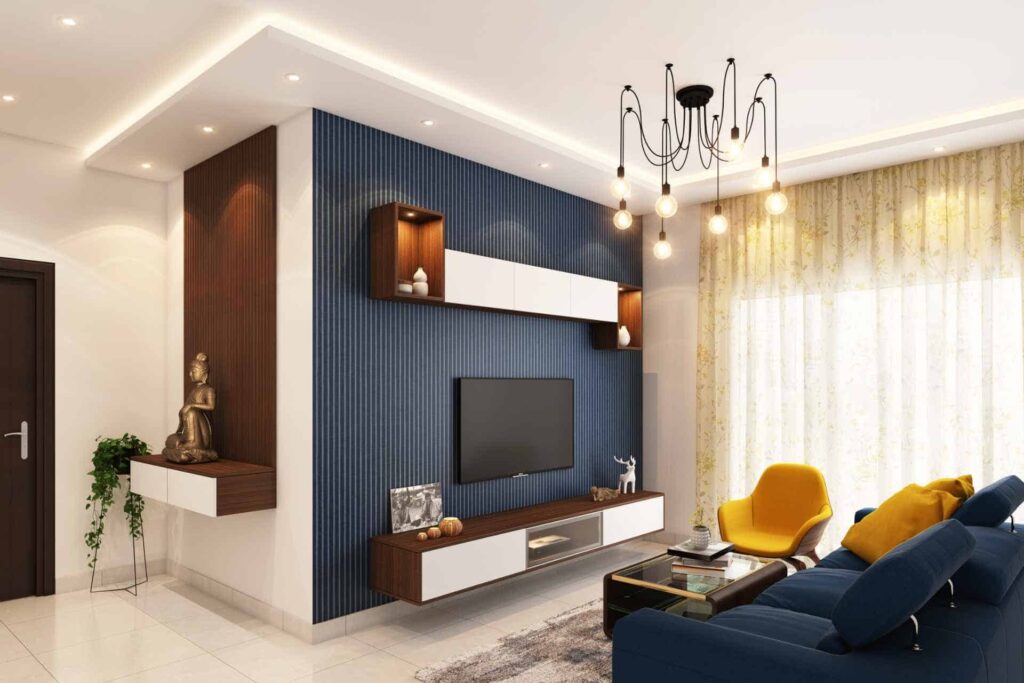
The use of color is a powerful tool in interior design, especially in rooms with high ceilings. A smart color strategy can help to visually lower the ceiling, creating a cozier, more intimate atmosphere. Darker hues, when applied to the ceiling, can make it seem lower and less daunting. Similarly, painting the walls in warm, rich tones can make the room feel more welcoming and less vast. Contrasting colors can also be used to highlight architectural details or to create a focal point. For a harmonious and balanced look, it’s advisable to stick to a cohesive color palette throughout the room. Carefully chosen, color can work together with the room’s furnishings and decor to create an inviting space that feels proportional and well-balanced, despite the high ceiling.
Window Treatments

Window treatments are an indispensable element in rooms with high ceilings and they can significantly influence the room’s overall ambiance. Floor-to-ceiling drapes can create a dramatic impact, whilst visually lowering the ceiling. They also connect the lower and upper parts of the room, ensuring a cohesive look. Opting for layered window treatments, such as sheer curtains under heavier drapes, adds depth and sophistication to the room. Alternatively, Roman or Venetian blinds in a striking pattern or color can draw the eye and serve as a focal point in the room. When selecting window treatments, it’s essential to consider the room’s overall aesthetic and color scheme, and to ensure that they enhance, rather than detract from, the room’s decor. Keep in mind that window treatments aren’t purely decorative; they also provide light control and privacy, which are key to creating a comfortable and functional living space.
Floor Decor

Floor decor plays a crucial role in balancing the aesthetics of a room with high ceilings. Strategically placed floor rugs, for instance, can anchor the room and draw the eye downwards, counteracting the feeling of vastness created by a high ceiling. Opt for rugs with bold patterns or rich colors that correspond with your overall color scheme to create a sense of harmony. Additionally, tall floor lamps or large sculptures can bring scale to the room, making the ceiling appear lower. When choosing floor decor, remember to provide enough open space to allow for easy navigation around the room. Like window treatments, floor decor must serve a functional purpose in addition to enhancing the room’s aesthetic appeal. It should contribute to the overall comfort and usability of the space, all while balancing the striking architectural feature of a high ceiling.
Incorporating Focal Points
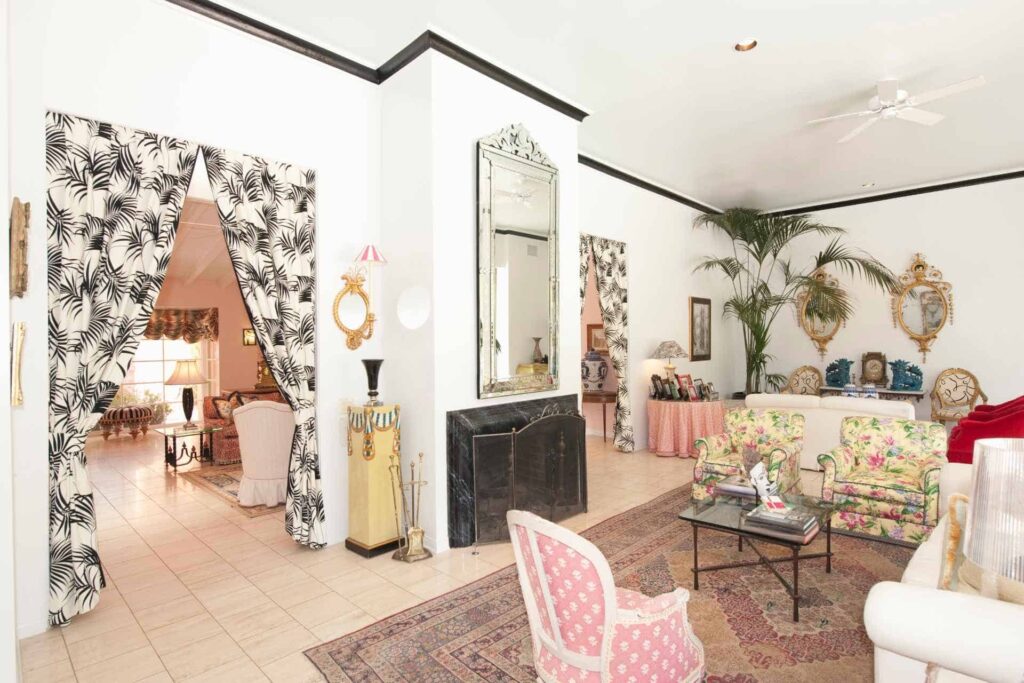
Creating a focal point in a room with high ceilings can effectively draw the eye and make the space feel more intimate. For example, a grand fireplace, an oversized piece of artwork, or a feature wall painted in a contrasting color can serve as a strong focal point. These elements can help break up the height of the room, adding interest and dimension. They should harmonize with the other elements in the room, including the window treatments and floor decor, to create a cohesive and balanced aesthetic. When incorporating these focal points, consider their scale and positioning, aiming to create a balance that complements the room’s high ceilings. Providing a focal point is not only a visual anchor but also a conversation starter, making the room feel welcoming and engaging.
Considerations for Curtains and Drapes

When it comes to rooms with high ceilings, curtains and drapes play a pivotal role in defining the space. The length of these window treatments can significantly impact the room’s overall aesthetic. To enhance the height of the room, consider floor-to-ceiling curtains. These create a continuous visual line, helping to emphasize the room’s verticality. The choice of fabric also matters, heavy fabrics like velvet can add a feeling of luxury and warmth, while lighter materials like linen can lend a more casual, airy feel. The color and pattern of the curtains or drapes can also impact the room’s ambiance. Bold colors or large-scale patterns can make a dramatic statement, while neutral colors and subtle patterns can help create a tranquil, sophisticated space. When choosing curtains or drapes, remember to consider the other elements in the room, aiming for a cohesive look that enhances the room’s overall aesthetic.
Use of Accents and Accessories

Accent items and accessories are the finishing touches that can truly elevate a room with high ceilings. These could include statement light fixtures, large-scale artwork, tall indoor plants, or high shelving units. These elements work to draw the eye upward, enhancing the room’s verticality. Light fixtures, in particular, can serve as striking focal points, especially when hung at different levels. Art pieces and mirrors can be hung a bit higher than typical eye-level to utilize the wall space effectively. Tall indoor plants can bring a touch of nature indoors while also filling empty vertical space. High shelving units, on the other hand, provide both storage and display options. They also help create a sense of scale and proportion. The key is to not overwhelm the space. Strategically place these accents to complement the room’s design without making it feel cluttered. These accessories should also match the room’s color palette and style to ensure a harmonious decor.
Conclusion
In conclusion, decorating a room with high ceilings can be a unique interior design challenge, but with careful planning and thoughtful selection of elements, the result can be a sophisticated and inviting environment. Emphasize the grandeur of the room by choosing appropriate paint colors, curtains, or drapes, and strategically using accents and accessories. Statement light fixtures, large-scale artwork, tall indoor plants, and high shelving units can effectively utilize the vertical space, while maintaining proportion and preventing clutter. Remember to integrate these elements cohesively, keeping in mind the overall aesthetic of the room. With these considerations, a room with high ceilings can become a stunning space that beautifully balances scale, proportion, and style.


